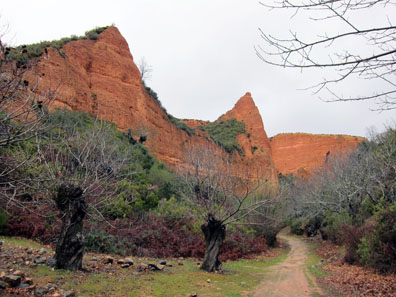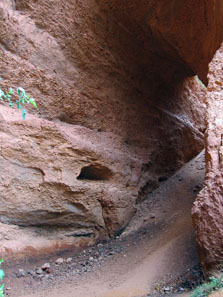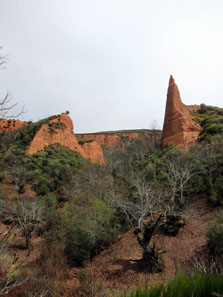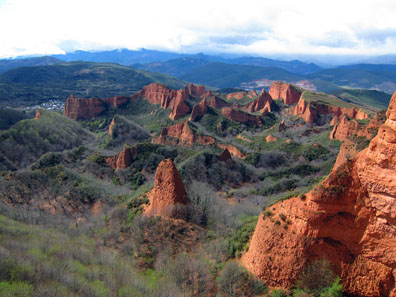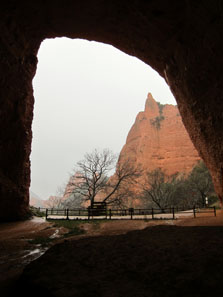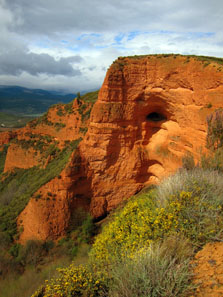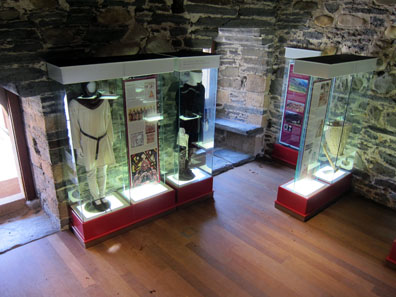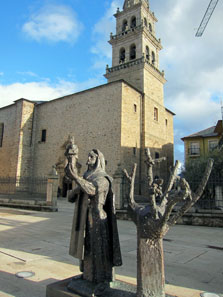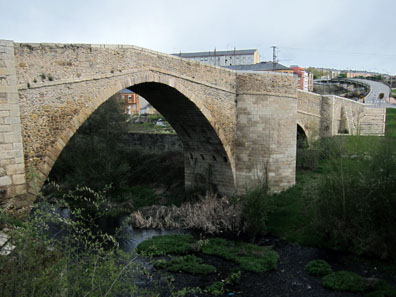by Ursula Kampmann
August 30, 2012 – You’ve probably never heard of Las Médulas. And yet, this site of the most important gold mines of the Roman Empire is now a designated UNESCO World Heritage Site. The landscape of Las Médulas is staggeringly beautiful, so much so that we were distracted to the point of nearly getting completely lost.
Wednesday April 14, 2012
With heavy hearts, we left our parador in Baiona. Right up till the last minute, we had been toying with the idea of maybe taking one more day just to rest, but our indecision was quickly vanquished by hundreds of women suddenly rushing into the parador all at once. Apparently some publisher or another was presenting a preschool program for children. So much for the silence and serenity we had been so enjoying! We cast one last plaintive glance at the parador and hauled our bags (which were somehow getting heavier by the day) into the car.
We were on our way to Las Médulas, once the most important gold mine of the Roman Empire. It was here that the emperors acquired the precious metal with which to mint their aureii. The route here alone was impressive – we drove through a mountainous landscape, where sun, heavy showers, black clouds and fog all took their respective turns gracing us with their presence. The Rio Sil flowed below us, the road wound its way along the mountains … let’s just say that we barely even noticed how far it actually was to Las Médulas.
First look at the red rock spired ruins of Las Médulas. Photo: KW.
The first thing we saw when we arrived was just a village, with one or two of the characteristic red rock peaks. It was a symphony of red and green, looking like something straight out of a Wild West film. It was no natural process of erosion that created this unique landscape, however, but rather thousands of slaves who hauled gold from the earth here to deliver as material for the Roman Emperor’s aureii.
Mountain caves formed from being washed out. Photo: KW.
Water was the most important component of the excavation methods used in Las Médulas. Trenches, dikes and cavities were filled with it in order to float the sediment and loosen the gold from the stone. The most impressive excavation method was that described by Plinius under the name ruina montium. Once the mountain was so full of holes that it became dangerous to excavate any further, the cavities were then filled with large quantities of water, causing pressures significant enough that the mountain would be undermined, or at least large parts of the rock would fragment.
These are no natural mountains, but rather the remains left after the entire mountain caved in. Photo: KW.
By this point, there would have been enough gold-bearing rock to begin the process of leaching it out. The slaved performed this task too, and it was dangerous work. Going by the reports of Plinius, 20,000 Roman pounds came from the Las Médulas mines every year. Seeing as Plinius was himself Procurator in the provinces of Hispania in the year 74 AD, his account of things is probably pretty accurate.
A look at the entire mine area. Photo: KW.
We were then faced with the problem of how exactly we were going to see any of the gold mining area. It was huge, with signposts everywhere touting various intriguing, unknown sites of interest. For one of these sites, the climb was an hour, for another, three hours. By the time we found a visitor information centre, we were feeling just a little bit disoriented. The three lovely women there (one even spoke English!) told us that yes, there was quite a lot to see in this area. They recommended that we do a little circuit tour of about five kilometres where we’d see two typical ‘rock remains,’ and that we should also go to the observation point (and then climb another kilometre or so). They then took a look at our footwear and shook their heads somewhat worryingly. I’ll admit I hadn’t really given too much thought to it. I had very good runners on, but they weren’t waterproof, and by now it had been raining for a while … Our lovely advisors sent us on our way, but not before warning us that the routes to the various attractions might just be a bit mucky …
Sweet chestnuts, there were leaves and fruit all over the ground. Photo: KW.
A little dirt wasn’t going to quell our curiousity and thirst for knowledge! We set off, and it wasn’t raining, so we excitedly went to look at the red mountains and noticed the many sweet chestnuts, which the Romans had imported to Spain in order to provide the slaves with cheap sustenance.
Safe from the rain in the large caves. Photo: KW.
The real rain started just as we reached the first cave, La Cuevona, and so, completely ignoring all the barriers meant to keep us out, we sought shelter. In the meantime, my once black shoes had become a sort of reddish-brown from the clay-rich ground. We were wet and dirty and it was a lot of fun making our way to the next cave, Encantada.
From there, we walked further along the wide path under our umbrella, hoping that this was the ‘short route’ that the women at the visitors’ centre had been referring to. It didn’t take too long before the whole thing actually became scary – we were the only tourists there (Quite the feat, that – but it seems that not every tourist loves traipsing uphill through clay soil!) What’s more, the map that we’d picked up at the information centre seemed better suited as a little art piece than an actual topographic reference tool, a hunch fully confirmed as we suddenly spotted the observation point of Orellán. According to our map, we were going completely the wrong way. We were going to come out at another village! Hours away from our parking lot! It was almost four o’ clock! We tried to calculate how many hours of daylight we had left and wondered if there were any taxis here at the end of the world that might bring us back to the other village. And just as we were imagining this absolute worst-case scenario, we suddenly spotted a descent. And what do you know – when we emerged, we were very close to our parking lot after all.
The view from the observation point. You could also go underground, where you can see the giant cavity in the rocks. Photo: KW.
On the strength of this successful experience, we had the courage to venture off to another mirador (observation point). We drove to the neighbouring city, Orellán, and from there to the signed parking lot. After that, climbing was the name of the game – and I’m completely convinced that it was much more than the stated ‘700 metres.’ Once we’d reached the top, though, all the panting and sweating were quickly forgotten. The view was phenomenal! Plus, it had also stopped raining, and the scattered rays of suns made the red stone almost glow.
Just below the observation point was another very special site of interest – a Roman passageway by which you can reach an observation point right in the middle of the mountain. I procured a ticket, put on the white hairnet and the yellow helmet, grabbed two flashlights (just in case one failed) and climbed into the passageway. I hadn’t gone five metres before my heart was in my mouth – this was no normal trek. In certain parts you could only move by crawling. Also, nothing was signed and there were more passageways to choose from, all of them lit by just a tiny beam of light.
I turned around in as dignified a manner as I could muster and explained to the confused cashier that, although I’m sure it must be amazing, it just wasn’t for me. So, unfortunately I can’t give you a firsthand account of what it feels like to be in the middle of one of the mine corridors. I experienced such claustrophobia just in the entrance area that all subsequent experiences could be spared.
The Knights Templar shape the cityscape of Ponferrada. Photo: KW.
From Las Médulas we made our way to Ponferrada, the last major town on the Way of St. James before the pilgrims once reached Santiago. We got there shortly after five. It wasn’t raining, so we decided to go into the city right away. After all, with weather like this you really have to take advantage of every hour of sun!
The entrance to the Castle of Ponferrada. Photo: KW.
After a quarter of an hour of trekking, we found ourselves standing completely awestruck and overwhelmed before a fairytale-like castle that once belonged to the Templars. In 1178, Ferdinand II of León donated the city to the Templar Order in order to protect the pilgrims on the Way of St. James. The Grand Master of Castille stayed in the huge castle that was built in order to fulfill the task. After the order disbanded in 1312, the fortress, which covers about 16,000 square metres, came into the possession of Spanish nobles. Various nobility lived here before the structures were partly razed in the Spanish War of Liberation against the French rule. The impressive wreckage that was left has seen a very diverse range of uses, including serving as a football stadium shortly after the turn of the 20th century.
A look into the exhibition rooms. Photo: KW.
In 1924, the castle was given national cultural heritage status (although it was called something else at the time) and the first preservation efforts got underway. Today, it houses an impressive museum, whose various rooms offer an insight into the social history of the Middle Ages.
The Templar legend is maintained. Photo: KW.
Of course there’s also plenty of Templar legend on offer here, some courtesy of a ghoulish voice that tells of the demise of the Templars in the red-lit basement.
But as far as a numismatic travel guide is concerned, it’s much more important to mention here that the Templars were decidedly in favour of Europe’s economic development. Their large and powerful organization, whose members were sworn to personal poverty, was so trustworthy that many gave over bequests for their salvation after death, or in living, donated all their property and possessions to the Order, at least for the time that they were participating in the crusades. The Templars often advanced the funds for the expensive knightly equipment and were compensated for these advances in that they were permitted to take the proceeds of the administered goods.
The castle in Ponferrada covers an unbelievable 16,000 square metres. Photo: KW.
They were successful and innovative. The remittance is the work of the Templars – a knight would pay a sum on-site to a local outpost and receive a letter of credit, the amount of which he could get back as needed at other outposts along his route. Soon the Templars were using their resources to operate as a bank. They elegantly sidestepped the fact that the church forbid lending money in return for interest by providing the money, and in return, retaining control (at least until the loan was repaid, which often never happened) over the land and bondsmen in the secure West. The Order is said to have had about 9,000 holdings in Western Europe during its heyday, all fully legally autonomous and tax-free.
Philippe IV the Fair. Florin d’or “à la Reine” undated. (1305). Philippe as coronated king with sceptre of lilies, enthroned upon a curule chair. Fb. 255. From Künker auction 197 (2011), 5600.
It’s little wonder that a king would have felt threatened by the power held by the Templars, but ultimately, it was their wealth and prosperity that led to the demise of the Order. The French ruler, Philippe IV, was waging war against England and needed money, and had hoped he might be able to receive a loan from the Templars. They refused. Philippe was furious and assigned a royal law that gave him the right to tax the clergy and its possessions. But in the eyes of his contemporaries, this action overstepped his jurisdiction. Philippe tried to convince Pope Boniface VIII to enforce the royal law upon the Templars and excommunicate them, to which the pope reacted with excommunication all right – but Philippe’s, not the Templars. Philippe reacted by sending his soldiers to kidnap the pope in Anagni. The people of Anagni eventually rescued the pope, but he died a month later from aftereffects of the crime.
Following a brief interlude, the French cardinals succeeded in making one of their own the next pope. Clement V was a personal friend of Philippe. He not only moved the papacy to Avignon, but also gave the approval for the removal of the Templars. They were charged in a show trial, tortured, sentenced and executed. This, of course, brought the king great fortune, but it was a huge shock to economic life throughout Europe. The Knights of St. John also renounced their active economic role, despite the fact that they had profited considerably. The pope had donated the Templars’ holdings to them, provided that the rulers weren’t more in favour, as was the case in Ponferrada, of bringing the castles under their control.
St. Toribius. Photo: KW.
After the castle we took a little sightseeing walk through Ponferrada, which is truly a beautiful town. We paid a visit to the main square where we saw a statue that told us how the statue of the Virgin Mary of the pilgrimage church of Our Blessed of the Oak had made its way to Ponferrada. Around 1200, the knights suddenly ‘discovered’ an old picture of the Virgin Mary that St. Toribius, Bishop of Astorga, had brought back to Jerusalem from a pilgrimage many hundreds of years earlier. The story seemed to fit the bill, and succeeded in attracting even more pilgrims to Ponferrada.
The “iron” bridge. Photo: KW.
Incidentally, have you ever wondered where Ponferrada got its name? Again, it comes from the Latin. ‘Pons’ stands for bridge and ‘ferrada’ for ferrata, so it means, ‘a stone bridge reinforced and secured with iron.’
The radio museum “Luis del Olmo Marote.” Photo: KW.
There’s another attraction in Ponferrada – a radio museum established by and dedicated to the work one of Spain’s most well known radio journalists, as well as that of the radio institution.
Portable crucifixion scenes. Photo: KW.
We were met by little plaster statues of penitents in all the souvenir shops, as they would have appeared dragging the large Stations of the Cross through the city during the fasting period. We then looked at huge racks with life-sized figures in a church, but by then, we’d finally had enough.
Needless to say, we were completely spent after such an eventful day. For once though, we didn’t have a parador waiting for us. There was a wedding happening in the only one nearby and they had already warned us over the phone that it might get loud. So, our hotel didn’t rank up there with the elegance or comfort of the paradors, but when you’re exhausted enough, you can ignore even the sound of the revving motorcycles of all the kids headed home from the disco at 6:00 am …
Be sure to join us for the next leg of our journey over the Rabanal, the pass that, according to an old pilgrim tune, cost many Germans their lives.
And then it really gets numismatic – we reach León, the capital city of the kingdom of the same name, and the mint of the kings of Castille and León.
You can read all other parts of this diary here.



